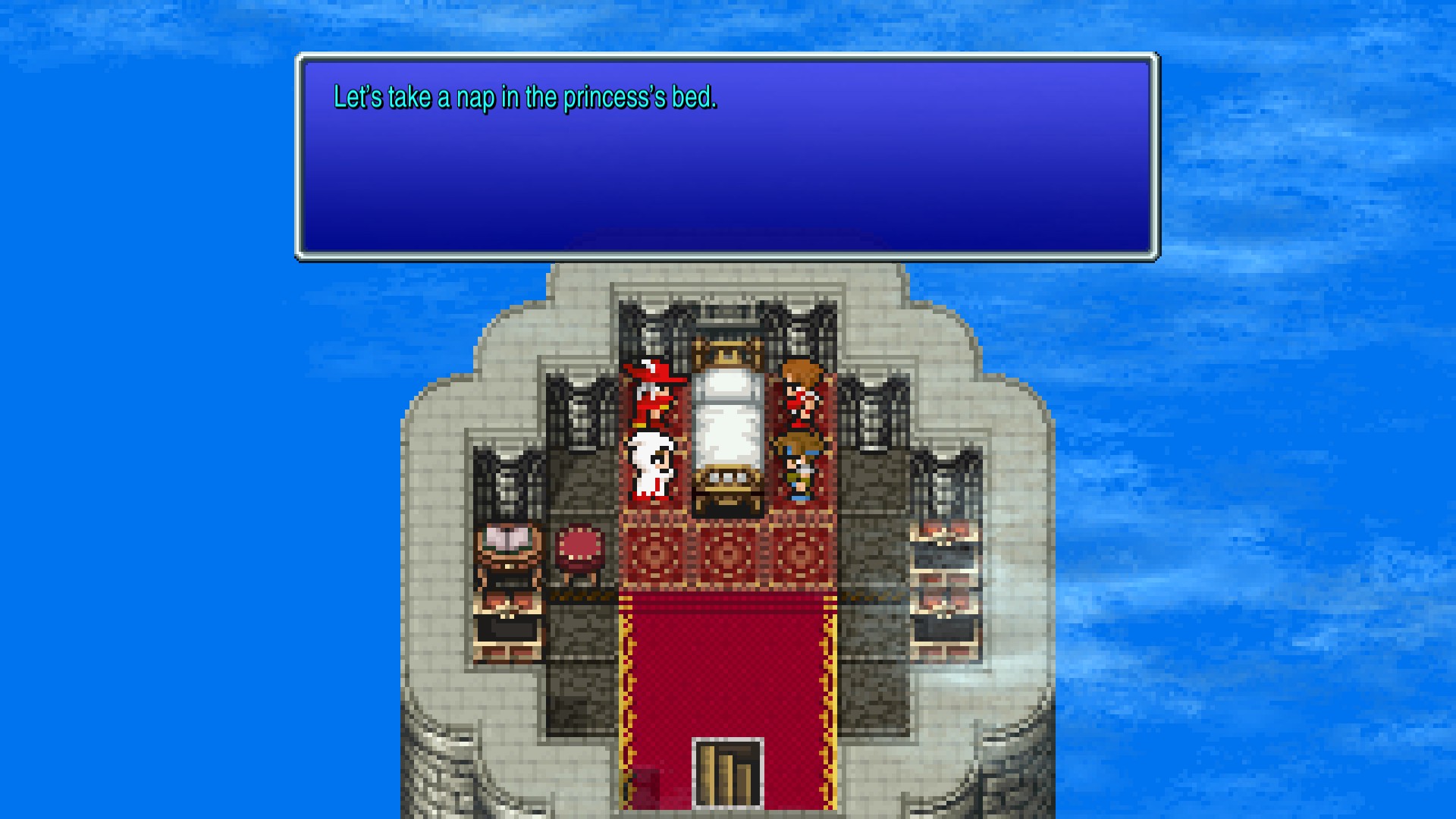

"Let's take a nap in the Princess' bed!"
Four youths who went to explore the Altar Cave after an earthquake rocked the floating continent. There, they fell into a hole and discovered monsters in the cave. In the depths, they found the Wind Crystal, which dubbed them Warriors of the Light and granted them the ability to use jobs.
Final Fantasy III is sort of an odd man out, as it is the only post-FFI, non-MMO game to not really give its main protagonists a set identity. Final Fantasy II stared Firion, Maria, and Guy as its main characters and even its fourth slot party members all had some sort of individuality or something that gave them an identity. Granted, it wasn't much, but it was there.
SNES-era onwards Final Fantasy games would consistently give its characters set identities, although the games up until X allowed the player to rename them at their leisure. Even Final Fantasy V, a successor to III, still has a distinct cast.
FFIII reverts to the FFI school of thought: A party of generic characters that the player themselves must characterize themselves. The four kids don't even have consistent names prior to the remake and even the Pixel Remaster, which specifically went out of its way not to use those names, doesn't even use actual names but rather SQEX 01-04. Even so, it has differences: The Warriors of Light of the first Final Fantasy were pure blank slates, having no dialogue and appearing mysteriously holding Crystal fragments, with no hint of their pasts. By contrast, III has the four be orphans from the town of Ur and gives them dialogue. Not thrilling dialogue, mind you, but that's more than the FFI party had going for them.

A line so bold, it became a meme in Japan
Even so, the Onion Knights still fulfill their role, with their only individuality being their armor colors:
The fourth Onion Knight doesn't really have a consistent color: In the original, the fourth Onion was exactly the same as the first. The rare sighting in one of the Itadeki Street games had a Yellow Onion. The Pixel Remaster opts for a lighter shade of red that is honestly more pink than anything.
Of course, none of this matters when you actually get around to the jobs, as one Warrior looks exactly the same as the other Warrior. Still, job progression is basically character development in FFIII: Thanks to the job system, your characters are constantly switching jobs. While FFI's sense of character comes from the jobs they use, the Onion Knights are more based on their job trajectory; They start as one job and will more than likely end as one of three different jobs (one of which is the job they start the game as), so it's that middle stretch that defines them. This is especially true if one plays by the rules of the non-PR versions, which encourage sticking to certain roles for each.
All in all, there's something to be said of the Onion Knights' blank slate-ism. Final Fantasy III is a NES-era RPG, meaning that it doesn't have much on the more graphically flexible later games in the series. Final Fantasy V, the next game to use the job system, would give each of the Warriors a unique outfit for each job. Then the 3D era came in and games that featured the job system took advantage, including III's own remake that went for a middle ground: consistent job outfits with unique touches for each character.
In contrast, the NES era didn't have as much to work with, especially with the recycled assets: Firion, Guy and Leon recycled sprites from FF1 (indeed, Firion and Leon both use the Warrior for their basis). FF3, in turn, uses several sprites from FF2, such as Gordon and Ricard being repurposed for the Scholar and the Dragoon in addition to touching up the further reused FF1 assets.
Interestingly, the idea of giving the protagonists distinct personalities was considered for the famicom release, according to Hiromichi Tanaka in an interview in the 3D remake's official (Japanese) strategy guide, only to be dropped in response to Final Fantasy II. One of Tanaka's explicit goals for the remake, especially with it being in 3D and taking advantage, was to give the protagonists explicit identities. Thus, we got Luneth, Arc, Refia and Ingus.
Dissidia Final Fantasy reinvented the Onion Knight as a unique character (indeed, Dissidia's Onion Knight uses a different term from the job: 玉葱剣士 (FF3) vs オニオンナイト (Dissidia)). This variation of Onion Knight has become the defacto representative of III in general. In non-Dissidia works, such as Final Fantasy Record Keeper and Final Fantasy Brave Exvius, a variant of Onion Knight based on the classic portrayal is available (as the default costume for OK in Record Keeper and as a unit in Brave Exvius, rocking the classic outfit and silver hair), but they are still based closely on Dissidia Onion Knight. Even so, the classic design still gets throwbacks from time to time, such as the minion in Final Fantasy XIV.